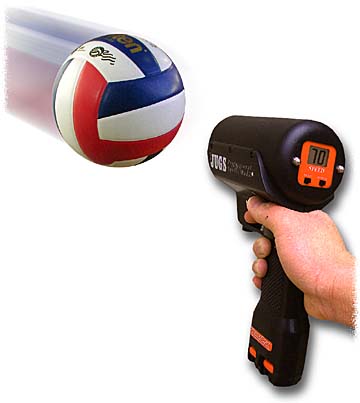Advertisement - Click to support our sponsors.

Friday, March 2, 2001

Stinging praises ON a hot day inside Gym 2 early this week, the University of Hawaii men's volleyball team found itself under the gun.
Everyone has their opinion, but
the speed gun has the only definitive
answer to which Warrior
hits hardestBy Pat Bigold
Star-BulletinThe speed gun.
The idea was to find out which Warrior has the fastest spike.
Inside the Stan Sheriff Center, everyone has an opinion about who hits the hardest.
Some say it's vertically gifted sophomore All-American outside hitter Costas Theocharidis. Others say it's rangy senior middle blocker Brenton Davis.
Still others say nobody can sting like sophomore outside hitter Tony Ching.
MATCH TIME
What: Two MPSF volleyball men's matches
Who: Hawaii vs. Stanford
Where: Stan Sheriff Center
When: Today and tomorrow, 7:05 p.m.
TV: KFVE
Operating the gun used by the baseball team to gauge its pitchers, head coach Mike Wilton spent a substantial portion of Tuesday's practice checking the speed of his hitters.
Serves were measured with Wilton holding the gun at about the 3-meter line.
Vernon Podlewski, the stocky 5-foot-8 team libero, was nominated to gun blasts at the net.
The amiable Maui native drew laughs when he took the gun and tucked himself inside a ball bucket on the opposite side.
He became Mr. Ground Zero, the target for a barrage of blistering shots.
Some balls violently rocked his perch.
"It was a little scary," said Podlewski, one of the NCAA's top 10 defensive players. "I felt like one of those rodeo clowns. I was afraid of getting hit in the head so I tried to get as deep in as I could."
Theocharidis, the team's kill leader (4.21 per game), maxed out at a team-high 70 mph with his drives over the net.
That's pretty fast when you consider that the ball weighs 10 ounces and is 27 inches in circumference.

Former Hawaii star Yuval Katz was once gunned at between 75 and 76 mph.Theocharidis served in the 60s and that also topped the team.
Davis, the team's top percentage hitter at .512, and Ching were the next fastest, recording 66 mph shots at the net.
Sophomore outside hitter Eyal Zimet, UH's leader in aces (.50 per game), checked in with deceptive 64 mph speed.
But the method used was far from pure science.
According to Robert Newton, Ph.D., director of biomechanics at the Ball State University Human Performance Laboratory in Indiana, it's not easy to get a true reading off a volleyball spike.
Newton, who has measured women's spikes at 40-45 mph, said the arm swing can confuse the gun.
He said he was surprised at the 70 mph reading for Theocharidis.

"Problems with the test are that the gun will record the fastest object in its field of view and so may pick up extraneous arm movement rather than ball speed," said Newton."It is an OK rough measurement technique. However, we prefer to use high-speed digital video cameras and then digitize the ball using a computer program and calculate ball velocity that way."
Newton said he plans to conduct a test in the near future to determine how much difference there is between calculations taken by the gun and the high-speed digital video cameras.
How do Hawaii's hardest hitters get their speed?
"A quick arm and quick wrist snap are most important," said Davis.
"If you can generate a lot of topspin, then the ball is going to maintain speed."
Davis said the speed readings taken at the practice probably didn't reflect actual game velocity.
"If you factor in adrenaline, that turns into a couple of extra inches on your vertical and for sure you're swinging a lot harder," he said.
Theocharidis agreed that game hits are harder.
"In a match, you're going to be more emotional, more fired-up," he said.
Theocharidis said his most torrid hits are line shots.
"Because they cover less distance," he said.
Podlewski plays a position that offers him insight into his teammates' hitting characteristics.
"Dejan (Miladinovic) hits hard but it's more straight down and hard to dig," he said.
Miladinovic's hits were also more difficult to gun and didn't get a reading out of the high 50s.
"Straight line shots, I'd say Tony Ching and Costas are best. Davis is straight down and angles."
Senior Torry Tukuafu had a late class that kept him out of the testing, but Podlewski said the 6-foot-5 outside hitter is probably one of the team's hardest spikers.
"He's a pretty big guy and I think he'd hit like about 72 mph," he said. "More angles."
While Wilton hopes to see his hitters raining thunderbolts on Stanford tonight, he doesn't think velocity is everything.
"Hitting hard is great, but hitting smart is more important," he said.
"You can't just bring heat all the time. You have to know when and where to hit."
Wilton couldn't conceal the enjoyment he derived from the speed gun session, though.
"This was fun," he said with a little laugh, "especially when Vernon climbed in the bucket."
UH Athletics
Ka Leo O Hawaii